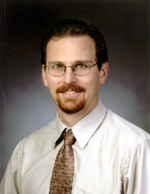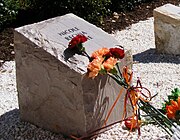Kevin Granata
Kevin Granata | |
|---|---|
 | |
| Born | December 29, 1961 |
| Died | April 16, 2007 (aged 45) Virginia Tech, Blacksburg, Virginia, U.S. |
| Nationality | American |
| Alma mater | Ohio State University Purdue University |
| Known for | Robotics and mobility expertise Cerebral palsy research |
| Scientific career | |
| Fields | Mechanical engineering Orthopedic surgery |
| Institutions | Virginia Tech Wake Forest University University of Virginia |
Kevin P. Granata (December 29, 1961 – April 16, 2007) was an American professor in multiple departments including the Departments of Engineering, Science and Mechanics (in which he was tenured) and Mechanical Engineering at Virginia Polytechnic Institute and State University (Virginia Tech), in Blacksburg, Virginia. Granata held an additional academic appointment as a professor in the Virginia Tech-Wake Forest School of Biomedical Engineering and was an adjunct professor at the University of Virginia in the Department of Orthopedic Surgery. During the Virginia Tech shooting, he shepherded students into his office in order to safeguard them. He was then killed by Seung-Hui Cho after he went to investigate and intervene.[1]
Education and career[edit]

A native of Toledo, Ohio,[2] Granata attended St. Francis de Sales High School in Toledo, where he played football and served on the debate team for four years, graduating in 1980 with a 4.0 GPA.[3][4] Granata was awarded a bachelor's degree in engineering physics & electrical engineering from Ohio State University in 1984,[5] a master's degree in physics from Purdue University in 1986, and a doctorate in biomechanics from Ohio State in 1993. He began his bachelor's degree in physics at John Carroll University in Cleveland, where he also played football,[6] before transferring to Ohio State to finish the degree.[4]
After earning his master's degree from Purdue, Granata worked for three years as a research scientist in the Applied Physics Lab at Johns Hopkins University. While there, he was contracted by the military and conducted research for the US Navy.[7]
Granata stayed at Ohio State for four years as a research scientist in the Biodynamics Laboratory after earning his doctorate degree there in 1993.
In 1997, Granata arrived at the University of Virginia as an assistant professor in two departments, Orthopedics and Biomedical Engineering, where he published two journals[8] and collaborated on a study with the Curry School of Education to determine why female athletes experience more knee injuries than their male counterparts.[9] From 1997 to 2003, he also served as the Research Director of the Motion Analysis Laboratory at Virginia. In 2002, he was promoted to the position of associate professor for the orthopedics and biomedical engineering departments. While at Virginia, he worked at the university's Kluge Children's Rehabilitation Center with children who had cerebral palsy.[10]
He remained an adjunct professor at Virginia after leaving for Virginia Tech in 2003.
Virginia Tech[edit]
Granata was among the leading U.S. researchers on biomechanics and movement dynamics in cerebral palsy, in his work with the Musculoskeletal Biomechanics Laboratory at Virginia Tech.[11] His research focused on muscle and reflex control and its relation to legged robotics, neuromuscular control of musculoskeletal movement, biomechanical stability and muscle dynamics, control of low-back pain, and computer simulation and clinical interpretation of pathologic walking and running.[12] Professor Granata was recruited to the Department of Engineering Science and Mechanics to continue his distinguished teaching and research. In particular, he developed innovative methods to quantify low back stability that are considered cutting edge by other leaders in the field. He served as mentor for numerous students and junior professors. When Granata was promoted to the rank of professor, one of these professors conveyed, "Countless times he has provided me with valuable guidance on research-related matters such as student advising, experimental issues, and manuscript preparation."[1]
Darin Padua of the University of North Carolina at Chapel Hill, who earned his doctorate under Granata's tutelage at the University of Virginia, said that Granata particularly excelled at encouraging collaboration among experts in various fields, resulting in research that crossed many disciplines and areas of expertise.[13]
While focusing primarily on research into cerebral palsy, biomimetric robotics and biomechanics, Granata helped develop mobility aids for the elderly such as the MARC Robotic Walker.[14] The MARC Walker is named for the Medical Automation Research Center at the University of Virginia, where Granata had taught until January 10, 2003. He presented a paper on the elderly walker at the 2003 International Conference on Robots and Systems in Las Vegas.[15][16] Granata was an associate professor at Virginia Tech and in 2005, he achieved the honor of Virginia Tech College of Engineering Faculty Fellow. In 2006, he was awarded the Dean's Award for Excellence in Research for his work on lower back pain.[17] In announcing the Dean's Award given to Granata, Virginia Tech stated he had "established a major research program, developing innovative methods to quantify low back stability that are considered cutting edge."[18] He was additionally honored as the Virginia Tech Scholar of the Week for his published work concerning lower back pain.[19] His friends and colleagues at Virginia Tech called him "a man with a sharp intellect who answered a call to serve the cause of scholarship and higher education".[1]
Granata was a member of many professional societies and served as Associate Editor of the Journal of Applied Biomechanics and Journal of Electromyography & Kinesiology. Granata was a co-chair of the American Society of Biomechanics' annual meeting in 2006, hosted at Virginia Tech.[20]
| Part of a series of articles on the |
| Virginia Tech shooting |
|---|
 |
| Location |
| Virginia Tech (Blacksburg, Virginia) |
| Perpetrator |
| Seung-Hui Cho |
| Victims |
| Related |
At the time of his death, he was awaiting publication of four more articles in his name.[13]
Personal life[edit]
Granata lived in Blacksburg with his wife, Linda Ankenman, whom he met at Purdue while they both participated in the Crew Club and married in May 1991. She is a research specialist in the Food Science Department at Virginia Tech. He enjoyed working with the Boy Scouts and other activities with his three children, and he was an avid athlete, participating in triathlons and biathlons for years.[7] On the crew club at Purdue, he was on the JV rowing team that won a bronze medal at the Dad Vail Regatta in 1986.[21] He loved to play golf and was a fan of Ohio State athletics.[22] Granata was also a member of Triangle Fraternity, inducted at Ohio State.[23]
Death[edit]
Granata was a victim of the Virginia Tech shooting on April 16, 2007. Upon hearing a commotion from his office on the third floor of Norris Hall, he brought 20 students from a nearby classroom into his office, where the door could be locked. He and another professor, Wally Grant, then went downstairs to investigate the situation when they were both shot by Seung-Hui Cho; Grant was wounded and survived from a shoulder injury, but Granata died from an injury to his temple. He was 45 years old. None of the students locked in Granata's office were injured or killed.[24]
One of Granata's fellow Virginia Tech engineering professors, Dr. Liviu Librescu, was also killed in the shootings. The Engineering Science and Mechanics Department Head, Dr. Ishwar Puri, remembered Granata and Librescu in a statement as "world-class" researchers. Dr. Puri stated about Granata, "The use of his research by other scholars worldwide had put him on a trajectory to become a notable star in these fields."[25]
Memorial services were held in Blacksburg and a funeral Mass at Christ the King Church in Toledo, Ohio, where his parents, Joseph and Mildred, and siblings live, was later held.
References[edit]
- ^ a b c "In Memoriam, Professor Kevin Granata Who Died While Serving Virginia Tech and ESM". Virginia Tech Engineering Science and Mechanics. April 16, 2007. Archived from the original on May 25, 2007.
- ^ "Sources: Toledo Native Among the Dead at VA Tech". Fox 19. April 17, 2007. Archived from the original on April 18, 2017. Retrieved April 17, 2007.
- ^ "Sources: Toledo native among dead; gunman's creative writings raised concerns". Toledo Blade. April 17, 2007.
- ^ a b "Sources: Ohio Native Killed in Shooting Spree at Virginia Tech". Fox Cleveland. April 17, 2007. Archived from the original on September 27, 2007. Retrieved April 17, 2007.
- ^ "SBES Faculty Expertise Listing" (PDF). Archived from the original (PDF) on September 20, 2006. Retrieved April 17, 2007.
- ^ "Family told Toledo native died aiding students; Granata relatives find some answers, solace". Toledo Blade. April 19, 2007.
- ^ a b "Chrys Peterson Talks with Shooting Victim's Sister". Toledo WTOL. April 17, 2007. Archived from the original on January 14, 2008. Retrieved April 17, 2007.
- ^ Chen, L. K.; Cadwallader, D. E.; Jun, H. W. (2015-04-20). "Response of trunk muscle coactivation to changes in spinal stability. - PubMed - NCBI". Journal of Pharmaceutical Sciences. 65 (6). Ncbi.nlm.nih.gov: 868–72. doi:10.1002/jps.2600650617. PMID 6782. Retrieved 2015-05-16.
- ^ "University of Virginia News Story". Virginia.edu. 2000-12-01. Retrieved 2015-05-16.
- ^ "Colleagues recall professors who died". Charlottesville Daily Progress. April 18, 2007.
- ^ "Aftermath of the Va. Tech Massacre". TMJ4. April 17, 2007. Archived from the original on April 21, 2007.
- ^ [1] Archived April 20, 2007, at the Wayback Machine
- ^ a b "St. Francis de Sales graduate among the victims of the Virginia Tech rampage". Toledo Blade. April 18, 2007.
- ^ "Eldercare Robotics: A Personal Mobility Aid". Archived from the original on October 15, 2006. Retrieved April 17, 2007.
- ^ "User Intent in a Shared Control Framework for Pedestrian Mobility Aids" (PDF). Archived from the original (PDF) on October 19, 2006. Retrieved April 17, 2007.
- ^ "Roboticist Killed in VA Tech Shooting". robots.net. Retrieved 2015-05-16.
- ^ "Virginia Tech 2004-05 College of Engineering Faculty Awards" (PDF). Archived from the original (PDF) on August 28, 2006.
- ^ "Outstanding Engineering Faculty Achievements Recognized" (PDF). Archived from the original (PDF) on February 7, 2007. Retrieved April 17, 2007.
- ^ "ESM Professor Kevin Granata Named Virginia Tech Scholar of the Week". Virginia Tech.
- ^ American Society of Biomechanics Annual Meeting: September 6-9, 2006 Archived August 28, 2006, at the Wayback Machine
- ^ "Kevin Granata, 45, former Purdue oarsman, killed in Va Tech shootings". Row2K. April 18, 2007.
- ^ "Triangle Mourns the loss of a Brother". Triangle Fraternity. April 17, 2007.
- ^ "Who they were - and what we lost". Boston Herald. April 18, 2007.
- ^ Downey, Kirstin (April 19, 2007). "Loss Creates a Terrible Contrast in Lives So Similar". The Washington Post. Retrieved May 7, 2010.
- ^ Hernandez, Raymond (April 17, 2007). "Victims of Shooting Are Remembered". New York Times. Retrieved May 7, 2010.
External links[edit]
- Kevin P. Granata Musculoskeletal Biomechanics Lab
- Dr. Kevin P. Granata, In Memoriam
- Dr. Kevin P. Granata, ESM Faculty
- MSNBC — Profiles of victims in Virginia Tech massacre
- "Victims of Shootings at Virginia Tech Remembered", Washington Post, April 17, 2007
- Photo of bronze medal-winning crew team at Purdue
- Photo of Purdue JV team on the medal stand at Dad Vail
- Biodynamics Lab at Ohio State
- 1961 births
- 2007 deaths
- American biomedical engineers
- Ohio State University College of Engineering alumni
- People from Toledo, Ohio
- Players of American football from Ohio
- Purdue University alumni
- Sportspeople from Toledo, Ohio
- United States Navy sailors
- University of Virginia faculty
- Virginia Tech faculty
- Wake Forest University faculty
- Mass murder victims
- People murdered in Virginia
- Catholics from Ohio
